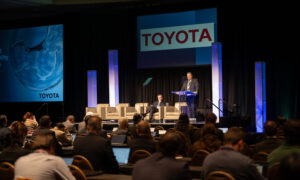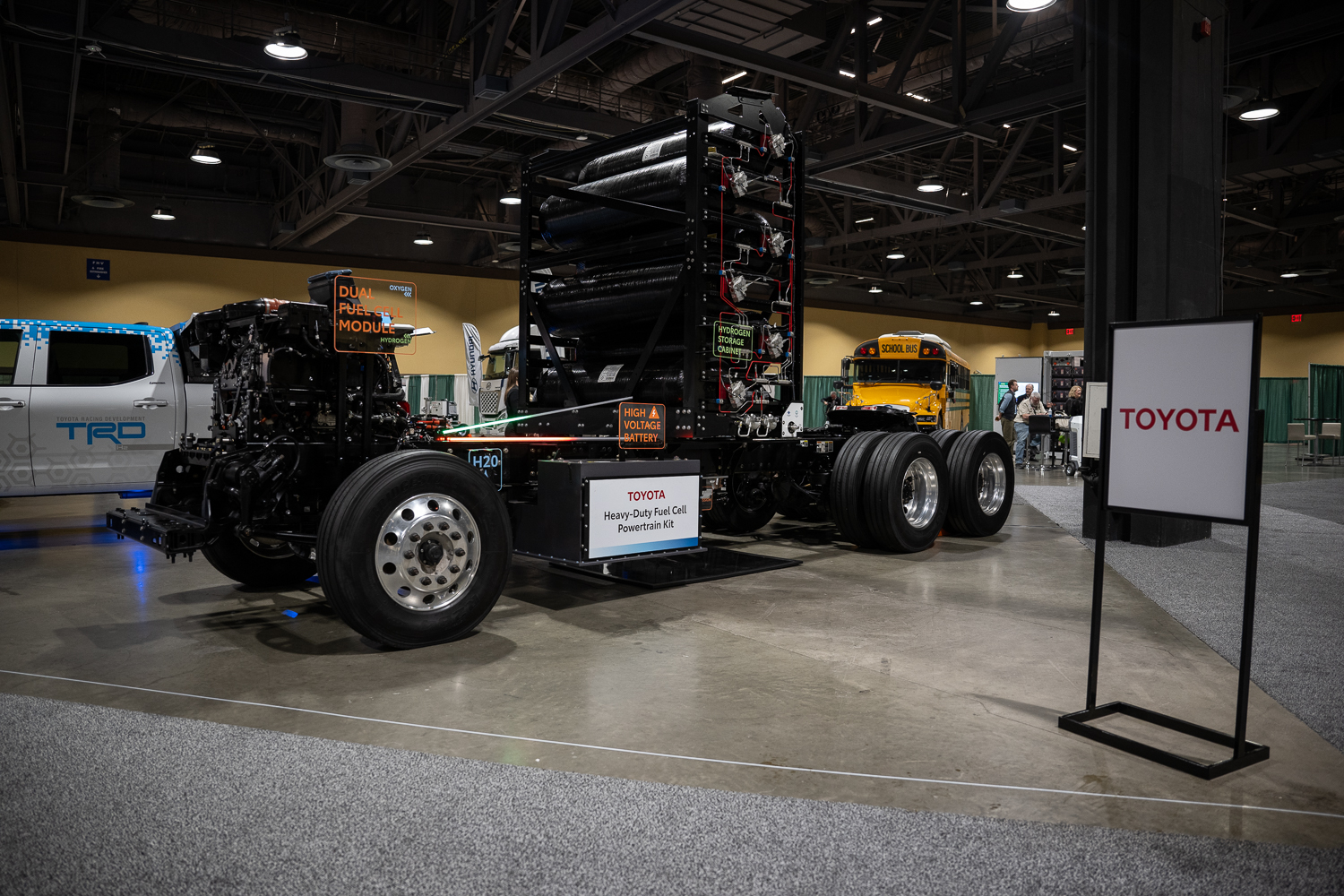
Toyota shares hydrogen-powered vehicle tech roadmap
By onAnnouncements | Technology
Toyota’s long-term strategy on the advancement of a hydrogen-powered society took center stage at the recent 2025 Hydrogen and Fuel Cell Seminar as executives presented and outlined the company’s vision and plan for achieving carbon neutrality.
“We are collaborating with companies that would traditionally have been our competition to develop standards for hydrogen fueling connections and protocols, recognizing that an industry standard was of greater benefit than our own competitive advantage,” said Jay Sackett, Toyota’s chief engineer of advanced mobility, according to a Toyota press release.
Many of Toyota’s public-facing efforts toward decarbonization have focused on hybrid, plug-in hybrid, and battery electric powertrains; however, Toyota says its hydrogen-powered fuel cell electric vehicles and powertrains remain an important part of its multi-pathway strategy.
Toyota believes hydrogen can play a role in the transition to a carbon-neutral future, particularly in sectors with significant carbon footprints, such as heavy-duty trucking, the release states.
An example shared at the event was how Toyota’s largest port vehicle processing center in the U.S., located at the Port of Long Beach, which processes upward of 200,000 vehicles per year, has applied the technology. With FuelCell Energy, Toyota built the first-of-its-kind Tri-gen system at the port.
“The system was designed to use directed renewable biogas and convert it to hydrogen, which is then used to produce 2.3 megawatts of electricity per day, part of which is used to power Toyota Logistic Services’ port operations,” the release states. “Some of the hydrogen produced by the system, up to 1,200 kg per day, is pumped to two adjacent stations, providing fuel for heavy-duty trucks and light-duty passenger vehicles.
“The third product of the facility is water. Tri-gen produces 1,400 gallons of water a day as a byproduct of the electricity generated by hydrogen — the Toyota team members use the water to wash vehicles when they come off shipping vessels. The system offsets 9,000 tons of CO₂ emissions per year from the Long Beach community.”
The port has about 30 fuel cell EV trucks in its rotation, all of which can take hydrogen produced from Tri-gen.
“While this is a small start, given the more than 20,000 heavy-duty truck routes operating daily in the area, including both the Ports of Long Beach and Los Angeles, Toyota sees a substantial opportunity to replace conventional diesel trucks with zero-emission, hydrogen-powered alternatives,” the release states.
FCEV trucks are capable of not only matching the payload capacity of their diesel counterparts but also allow greater up-time for drivers through significantly quicker refueling times than pure battery EV commercial trucks — 15 to 20 minutes for a full fuel cell tank versus 90 minutes on the quickest chargers available for a 90% battery charge — and emit only water vapor.
Toyota noted that it launched the world’s first mass-produced hydrogen FCEV, the Toyota Mirai, in 2014.
“That vehicle showed that Toyota’s polymer electrolyte membrane fuel cell stack could reliably convert hydrogen into electricity to power passenger vehicles,” the release states. “Those vehicles — and the millions of miles they’ve traversed in the ensuing decade — were only the start. Now, Toyota has shown that there are other use applications and cases to be found with the versatility and scalability of fuel cells.”
H2HQ, Toyota’s North American hydrogen headquarters in Gardena, California, has been co-developing the technology with Toyota Motor Corp. in Japan, from the earliest fuel cells and semi-truck applications to mobile and stationary generators, replacing diesel-powered generators in several applications, according to the release.
Thibaut de Barros Conti, general manager of fuel cell solutions, touched on how a Toyota fuel-cell-based generator is already in use as a backup generator in a hospital in the Pacific Northwest. On a smaller scale, a mobile generator built into a Toyota Tundra by TRD North America for motorsports and marketing activations was used to power the Hot Cocoa Village and Santa’s Workshop, presented by Lexus, at last year’s Detroit Christmas tree lighting.
On a much larger scale, a 1-Megawatt proton exchange membrane fuel cell power generation system using Toyota’s fuel cells was installed at the National Renewable Energy Lab in Colorado, and a future microgrid at H2HQ includes fuel cells in its design to enhance energy resilience.
Despite advancements in hydrogen technology, de Barros Conti said challenges still remain in the creation of a hydrogen society, including a limited number of stations available. Toyota has been taking steps to address the infrastructure gap in California, the release states.
As Toyota continues to innovate and expand its hydrogen initiatives, the company is committed to decarbonizing its logistics and trucking fleet, integrating hydrogen solutions where they make sense.
Calling upon the audience for collaboration, de Barros Conti expressed optimism.
“This has not been an easy road but it is the right road,” he said.
Images
Featured image: At the 2025 Hydrogen & Fuel Cell Seminar, Chief Engineer Jay Sackett and Fuel Cell Solutions General Manager Thibaut de Barros Conti shared Toyota’s vision for where they would like to see the technology advance in the U.S. (Provided by Toyota)
All photos provided by Toyota
More information
AkzoNobel ventures into hydrogen power with new spray booth, BMW with plant logistics
BMW announces hydrogen vehicle developed with Toyota for 2028
NHTSA proposes EV and hydrogen safety requirements, would include emergency response guides


